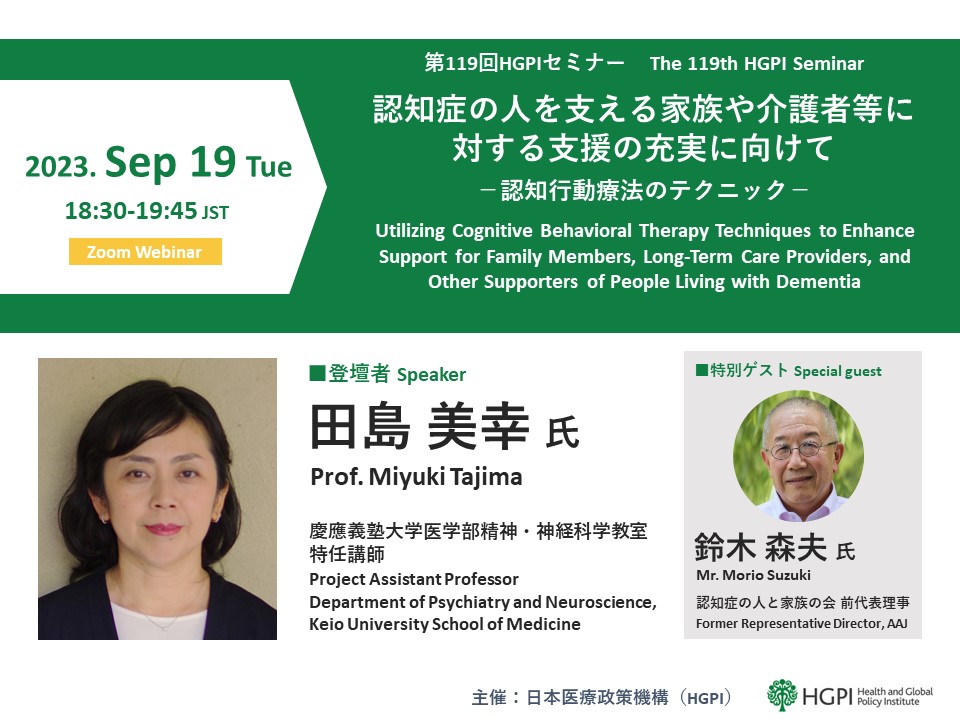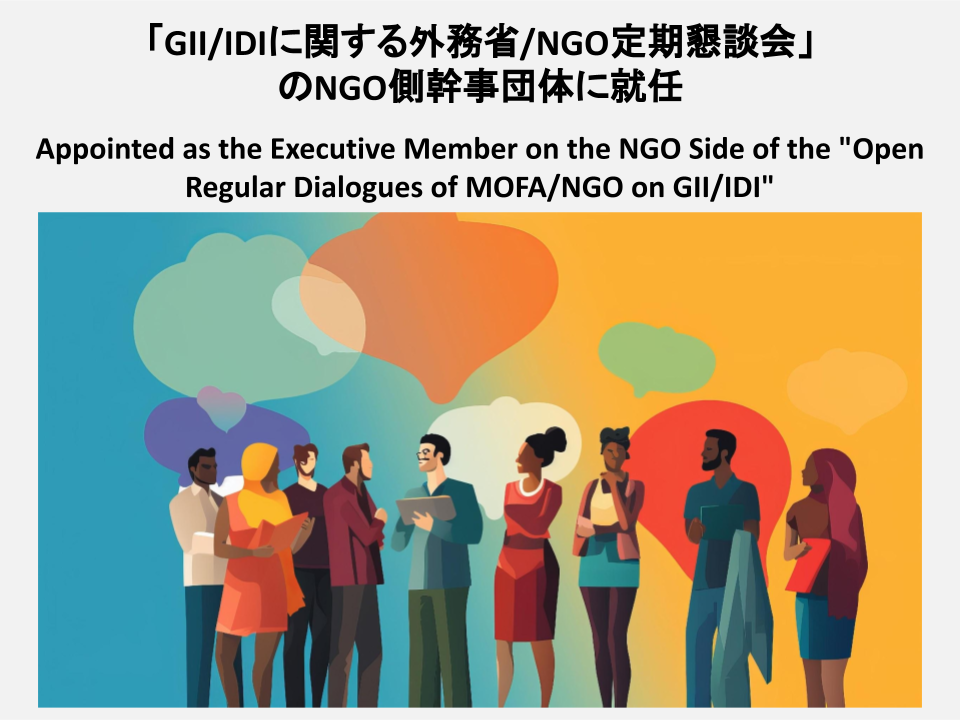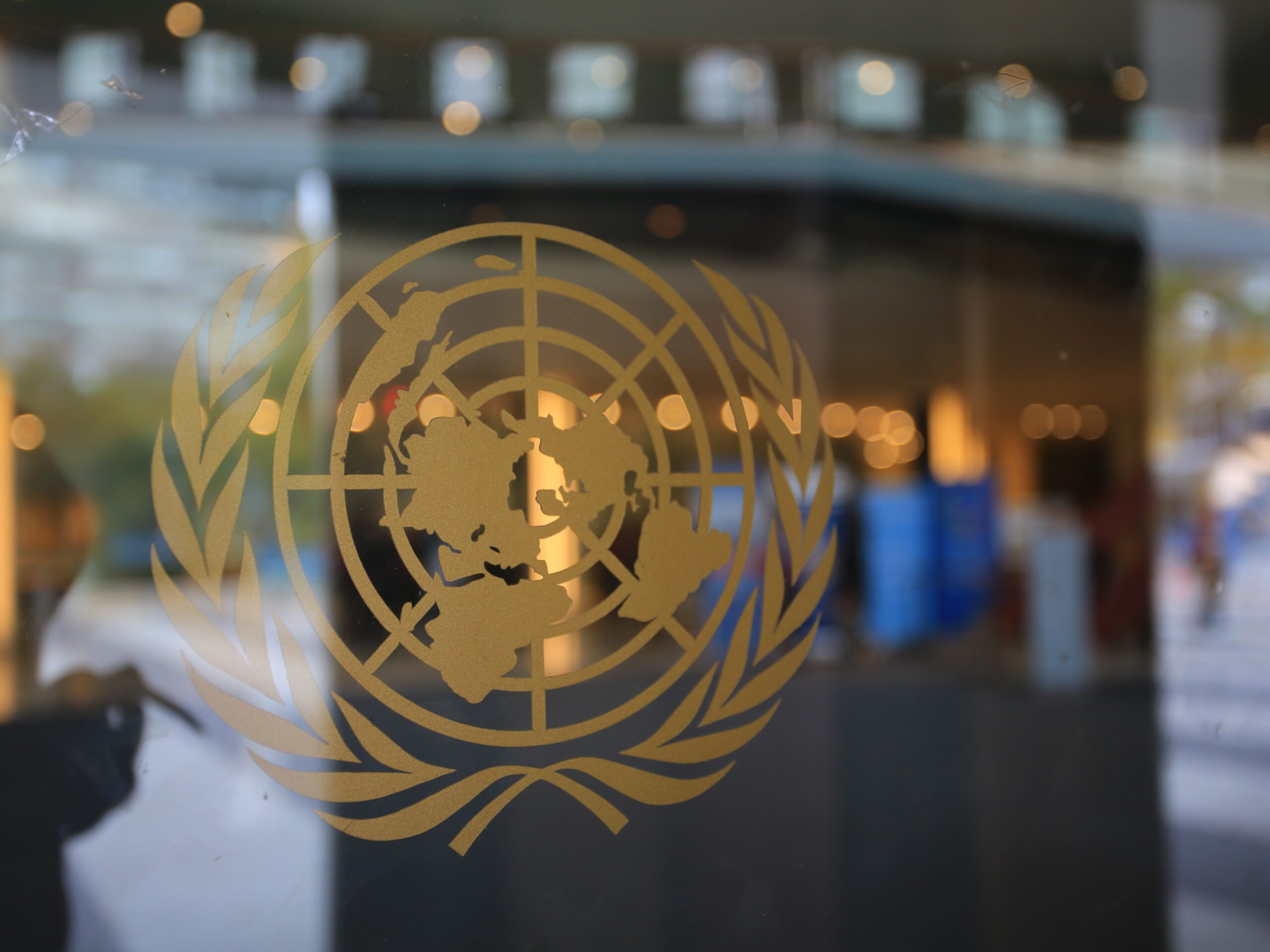[Event Report] The 118th HGPI Seminar “Trends in Global Health: Reflections and beyond on the G7 Hiroshima Summit” (September 6, 2023)
date : 3/25/2024
Tags: Global Health, HGPI Seminar
![[Event Report] The 118th HGPI Seminar “Trends in Global Health: Reflections and beyond on the G7 Hiroshima Summit” (September 6, 2023)](https://hgpi.org/en/wp-content/uploads/sites/2/hs118-top-1.png)
For the 118th HGPI Seminar, Professor Haruka Sakamoto (Associate Professor, Department of International Affairs and Tropical Medicine, Tokyo Women’s Medical University; Senior Manager, Health and Global Policy Institute (HGPI)) provided a report on international discussions on global health with a focus on the outcomes of the G7 Hiroshima Summit.
<POINTS>
- G20 members are increasing their presence, especially emerging countries such as China and India, and the G7 has been establishing global examples and trends based on the shared value of democracy. In global health, the 2016 G7 Ise-Shima Summit emphasized that reinforcing health systems and achieving Universal Health Coverage (UHC) will be essential for emergency response as well as during periods of non-emergency.
- Global infectious disease control requires systems for international cooperation, leadership to enable that cooperation, and the development of vaccines and therapeutics as public goods. While the importance of these elements has been pointed out in the past, the COVID-19 pandemic revealed the inadequacy of our actions.
- Based on the circumstances described above, as G7 President in 2023, Japan set three pillars at the G7 Hiroshima Summit: Global Health Architecture (GHA) (especially strengthening legal frameworks, including what are known as “pandemic treaties”); UHC; and Health Innovation. Each of these had characteristics of Japan placed at the forefront.
The significance of discussing health challenges at the G7
The Group of Seven (G7) comprises seven major economies (Canada, France, Germany, Italy, Japan, the United Kingdom, and the United States) and the European Union (EU). Together, they represent around 10% of the world population and account for around 40% of global GDP. The Group of Twenty (G20) includes the G7 economies and major emerging economies including Russia, China, India, Brazil, Argentina, Turkey, and Saudi Arabia. The G20 is a group with diverse values and enormous influence that represents approximately two-thirds of the world population and around 85% of the global economy.
While there are a number of conflicting systems both large and small among G7 members, they share the common value of democracy, which makes it easy for them to fall into step with each other. On the other hand, the G20 is prone to all forms of political dispute and their discussions do not always result in consensus documents.
Both the G7 and G20 were established to address economic and financial challenges, and it was only recently that both groups adopted health challenges as a major agenda item. Japan served as president of the G7 Ise-Shima Summit in 2016, the G7 Hiroshima Summit in 2023, and the G20 Osaka Summit in 2019. To discuss the more technical aspects of health issues, G7 and G20 Health Ministers’ Meetings have been held together with each Summit starting in 2015 and 2017, respectively.
How is the G7 significant? The first item to discuss is the extent to which G7 members can contribute to the world through their financial and technological capabilities. Many G7 members have a successful track record of rapidly conducting R&D while maintaining high levels of safety and effectiveness, as demonstrated by the Coronavirus Disease 2019 (COVID-19) vaccine. At the same time, several G20 members have enormous pharmaceutical manufacturing capacity or have had success in vaccine R&D.
Another discussion point is the establishment of values and standards. While this example is somewhat dated, in 2000, Japan hosted the G8 (the G7 and Russia) Kyushu-Okinawa Summit. Japan’s focus at the time was on the three major infectious diseases of HIV/AIDS, tuberculosis, and malaria. Japan proposed increasing investments, which later led to the establishment of the Global Fund. Rather than the G7 simply spending more on infectious disease control, this started an enormous trend in which countries around the world recognized HIV/AIDS, tuberculosis, and malaria as infectious diseases that required action and led to them scaling up control measures.
Changes in circumstances around the world
As noted in the 2022 report presented by the United Nations Development Programme (UNDP) titled, “New threats to human security in the Anthropocene,” threats to human wellbeing are increasing. In addition to health-related threats like Antimicrobial Resistance (AMR), COVID-19, or emerging and reemerging infectious diseases, human life is facing threats in various forms including the conflict in Ukraine and other geopolitical tensions, climate change, food and energy crises, and cybersecurity. These threats are complex and do not affect all people in a uniform manner. In particular, their impact is significant among people who are socially vulnerable. However, our safety nets are not necessarily functioning effectively and social unrest and confusion are spreading in Japan and around the world. At the same time, as shown by the conflicts in Ukraine and Gaza, the G7 and the international community have not always been able to mount adequate responses to these complex crises. This has led to increased scrutiny of the United Nations and the G7.
It was in this context that Japan became G7 President in 2023. There, we were asked what vision Japan had for global leadership from the G7 and how we should structure health systems in response.
Lessons from the G7 Ise-Shima Summit
From 2013 to 2014, an Ebola virus epidemic occurred in West African countries such as Guinea, Liberia, and Sierra Leone. Not only did this epidemic take many precious lives, it also had massive economic costs due to the loss of essential workers and the subsequent disruption of basic services that people use every day. The massive impacts of this epidemic gave rise to discussions on global health.
The first failure of the Ebola virus epidemic was that the world did not mount an effective response to prevent the disease from spreading across borders. The second was that global public goods like vaccines and treatments were not supplied in a timely and appropriate manner. This occurred, for example, when there was no Ebola virus vaccine in early 2014. The third was the absence of effective leadership. In particular, the World Health Organization (WHO) was criticized for its delayed initial response, slow and cumbersome decision-making, and structural problems.
While many years have passed since it was published, a 1998 article in The Lancet identified two roles of global health: core functions and supportive functions. It stated that core functions include the creation of global public goods such as vaccines and medicines and the control of international externalities, while supportive functions include supporting low-income countries and providing assistance to vulnerable people. However, these priorities were reversed during the Ebola virus epidemic, when focus was placed on providing technical assistance to low- and middle-income countries and supporting vulnerable people. The fact that the focus was not on core functions, where it should have been, sparked a massive debate at the time.
The G7 Ise-Shima Summit was held soon after the Ebola virus outbreak, in 2016. In addition to discussions on the importance of rebuilding the Global Health Architecture (GHA) and redefining the role of the WHO, the Summit also emphasized advancing UHC to respond to public health crises based on the concept that health systems can only respond to emergencies when a stable healthcare infrastructure is established during periods of non-emergency. In the following years after that Summit, the international community has continued holding discussions on the GHA, UHC, and responding to public health crises, but the unprecedented damage caused by the COVID-19 pandemic made it clear that there are still countless challenges left to address. Even today, discussions continue to be held on topics like the control of international externalities, the creation of public goods, and leadership and governance.
The G7 Hiroshima Summit and its outcomes
It was within this context that the G7 Hiroshima Summit took place from May 19 to 21, 2023. For this Summit, health sector discussions were based on three pillars: developing and strengthening the GHA; achieving more resilient, equitable, and sustainable UHC; and promoting health innovation. At first glance, it may appear that there were no significant changes to these basic pillars since the G7 Ise-Shima Summit in 2016, but after the COVID-19 pandemic exposed the inadequacies of the international community’s efforts, this was a way of returning to the starting point to consider more concrete commitments to promote, and how.
(1) Developing and strengthening the GHA
The GHA outlines how countries can cooperate and coordinate in the event of a pandemic or other public health crisis.
The first reason for discussing the GHA is the limitations of international organizations, starting with the WHO. In general, the decision-making bodies of such international organizations consist of their members, and at the WHO, decision-making can be influenced by the national interests and political agendas of each member state. This is a structural problem. The second reason is that while the WHO is funded through contributions from member states, in practice, the use of those funds is often limited to specific regions or countries. Even if the WHO is requested to take on a project to address a multidisciplinary issue with a certain budget, it may not always have sufficient financial resources available to do so. Similar to the first reason, the third reason is that member states make decisions not only out of national interest, but also from the perspectives of maintaining national security and influencing domestic public opinion. For example, since the time COVID-19 vaccines became widely available in 2021, discussions have been held on how to develop a framework for equitable distribution that would allow developing countries to retain access while preventing developed countries from buying up the entire vaccine supply. Looking at domestic public opinion in Japan, there was harsh criticism aimed at the Government in the spring and summer of 2021 because the vaccine rollout was very slow compared to Europe and the U.S. This led to Japan securing more doses than needed to vaccinate its entire population. In addition to these reasons, global health issues are growing more complex every year and now require human rights perspectives and economic considerations in addition to medical perspectives.
Despite the presence of these structural challenges, the need for better governance lies at the root of discussions on the GHA. While various governance issues require action, the main focus of discussions at the G7 Hiroshima Summit was international rulemaking. Specifically, those discussions examined two items that have attracted a great amount of global attention: the Pandemic Convention and review of the International Health Regulations (IHR).
Discussions on the need for a legal framework for pandemic response were held over the course of the COVID-19 pandemic in light of the pandemic’s enormous socioeconomic impact. In December 2021, an intergovernmental negotiating body (INB) was established to draft the WHO Pandemic Preparedness Treaty. The INB is expected to decide on a text for that treaty by May 2024 and is currently holding broad-ranging and active discussions covering a variety of key topics that include access to pharmaceuticals, promoting R&D, technology transfer, access to pathogens for the development of vaccines and therapeutics, and how to best structure the supply chain. An enormous amount of attention is currently on how players with different interests – namely, low- and middle-income countries and high-income countries – will come to an agreement on various points.
The IHR is a set of detailed rules on what actions countries must take when a public health threat is detected. They have existed since 1951 and have been revised several times. However, there are ongoing discussions on whether the IHR is sufficient for the COVID-19 pandemic. For example, it has been pointed out that IHR signatories are not incentivized to report public health threats and that there are no penalties for non-compliant governments.
Of course, the G7 alone cannot make final decisions regarding a pandemic treaty or the IHR, but it can be said that one outcome of the G7 Hiroshima Summit was that, to a certain degree, it set a common direction regarding what kind of rule-making will be necessary to respond to pandemics that will emerge in the future.
(2) Achieving more resilient, equitable, and sustainable UHC
Our next item to examine is achieving more resilient, equitable, and sustainable UHC. A country can be said to have achieved UHC when all people can access a full range of appropriate health services including those for prevention, treatment, and rehabilitation without financial or other burdens. While UHC is not synonymous with Japan’s National Health Insurance system, Japan achieved UHC in 1961 and has long been a proponent of UHC on the global stage. The international community has already developed a mental image in which Japan is linked to UHC and vice-versa.
Japan had already presented the concept that crisis response and UHC operate in parallel when it hosted the G7 Ise-Shima Summit in 2016, and the COVID-19 pandemic reaffirmed the need to advance these two items in tandem. This is because even if testing and control measures at international points of entry are implemented effectively, if there is no system to ensure those who do become infected can receive quality care without worrying about financial burden, infectious disease control measures will fail as a whole. In addition, the COVID-19 pandemic caused some countries to put off infectious disease control efforts that should have been maintained, such vaccinations for other infectious diseases, infant and maternal health checkups, and basic vaccinations for children. Some countries even had to suspend such efforts. The number of countries leading the world in UHC is limited, and I believe Japan’s continuous political momentum for UHC and efforts to convey its importance have received recognition from the international community.
Specific contributions for UHC from Japan include pledging more than US$7.5 billion to G7 financial contributions totaling more than US$48 billion for UHC-related funding and introducing an initiative to attract private investments called the “Impact Investment Initiative for Global Health,” or “Triple I for GH.” Japan has also laid out an action agenda on achieving UHC and has advocated the importance of a global hub function for actions like providing training on and developing human resources for UHC.
The 2023 UN High-level meeting (UN HLM) on UHC is scheduled for September 2023. There are very high expectations that Japan will continue to be a strong advocate for this agenda.
(3) Promoting health innovation
The promotion of innovation and R&D has been an active topic of discussion since before the COVID-19 pandemic. These discussions grew livelier when the COVID-19 pandemic made it even more apparent that vaccines, therapeutics, and diagnostic agents would be game changers, which led to the launch of the UK’s 100 Days Mission at the G7 UK Summit in 2021. The objective of the 100 Days Mission is to bring Medical Countermeasures (MCM) for public health threats to market within 100 days of an emergency declaration from the WHO. In Japan, there is a particularly strong sense of urgency about this issue because the country was unable to independently conduct its own R&D on vaccines and therapeutics. Focusing on the procurement of critical medicines, we see it is directly related to security, so in addition to reinforcing domestic research capabilities, Japan must also build a system for cooperating with partnered countries and ensuring stable domestic supplies of medicines during emergencies. From a global perspective, as pandemics affect the entire world and mass production requires collaboration among multiple countries, other necessary perspectives include collaborating in R&D and manufacturing on a global scale as well as ensuring equitable provision to the last mile.
When discussing innovation, R&D tends to become the focus of attention, but innovation is actually a topic that encompasses a wider range of items. If we consider the upstream portion to be the rush to gather information – determining the when, what, and why for infectious diseases or viruses that have emerged; if existing vaccines are effective; or how far clinical trials have progressed – then the midstream is basic research and clinical trials and the downstream is the process of manufacturing and delivering the product. Achieving the 100 Days Mission declared by the U.K. means measures must be taken for each item in this extremely broad process which spans all three portions, from upstream to downstream.
Topics at the forefront of discussions at the G7 Hiroshima Summit were generally in the downstream portion and included a vision for equitable access to MCMs and an examination of delivery partnerships, namely how to cover the last mile to deliver MCMs to the people who truly need them. During the COVID-19 pandemic, Japan did not let vaccines just pile up at airports, and instead chose to work proactively for last-mile support together with the United Nations International Children’s Emergency Fund (UNICEF) and the Japan International Cooperation Agency (JICA). I think this was a very Japanese way of presenting this topic.
The focus of discussions after the G7 Hiroshima Summit
There are two additional points to share regarding future international trends. The first is that in 2023, in addition to a high-level meeting on UHC, the UN will also hold high-level meetings on pandemic prevention, preparedness and response (PPPR) and tuberculosis. There is also a high-level meeting on AMR scheduled for 2024. We should pay close attention to how topics put forth at the G7 Hiroshima Summit are linked to these discussions.
The other point is activities at the G20. The G20 New Delhi Summit will be held in India in September 2023. The G20 Health Ministers’ Meeting was held one month earlier, in August, where topics of discussion included climate change and AMR. Another item of focus is drug discovery, particularly how to promote and solve issues related to technology transfer and drug prices while including perspectives from low- and middle-income countries. Another major topic of discussion is the digital transformation of healthcare, or healthcare DX, which is the promotion of digitalization for all healthcare services. It is likely that there will be significant progress on these agendas at the G20 Summits in India in 2023 and Brazil in 2024.
[Event Overview]
- Speaker: Haruka Sakamoto (Senior Manager, Health and Global Policy Institute / Associate Professor, Department of International Affairs and Tropical Medicine, Tokyo Women’s Medical University / Senior Fellow, the Tokyo Foundation Institute for Policy Research)
- Date & Time: Wednesday, September 6, 2023; from 18:30 to 19:45 JST
- Format: Online (Zoom webinar)
- Language: Japanese
- Participation fee: Free
- Capacity: 500
■ Speaker Profile:
Haruka Sakamoto (Senior Manager, Health and Global Policy Institute / Associate Professor, Department of International Affairs and Tropical Medicine, Tokyo Women’s Medical University / Senior Fellow, the Tokyo Foundation Institute for Policy Research)
After Professor Haruka Sakamoto, MD MPH, PhD graduated from Sapporo Medical University School of Medicine and served as an internist at St. Luke’s International Hospital, she worked at the International Affairs and the Maternal and Child Health Divisions of the Ministry of Health, Labour and Welfare (MHLW). She has represented Japan at various international conferences including the United Nations General Assembly and the World Health Organization (WHO) General Assembly. She also participated in organizing the G7 Ise-Shima Summit and the G7 Kobe Health Ministers’ Meeting in 2016. She attended the Harvard T.H Chan School of Public Health with a scholarship from the World Bank and received a Master of Public Health degree in 2014. In 2021, she received a Doctor of Public Health degree from the University of Tokyo. Her current roles include Associate Professor, Department of International Affairs and Tropical Medicine, Tokyo Women’s Medical University; Project Researcher, Department of Global Health Policy, the University of Tokyo; Consultant, WHO Western Pacific Regional Office; and Senior Fellow, the Tokyo Foundation Institute for Policy Research.
Top Research & Recommendations Posts
- [Policy Recommendations] Achieving a Sustainable Society of Health and Longevity Through the Integration of Environment and Healthcare-Incorporating a Planetary Health Perspective into the 3rd Phase of The Healthcare Policy-(December 20, 2024)
- [Research Report] Building a Mental Health Program for Children and Measuring its Effectiveness (June 16, 2022)
- [Policy Recommendations] Integrating Climate and Health for a Sustainable Society: Incorporating a Planetary Health Perspective into Nationally Determined Contributions (NDCs)(December 9, 2024)
- [Policy Recommendations] Policy Recommendations on Strengthening CKD Strategies for Workers: The Importance of Providing Early Detection, Intervention, and Support Through Screenings and Medical Visits (October 28, 2024)
- [Research Report] The 2023 Public Opinion Survey on Satisfaction in Healthcare in Japan and Healthcare Applications of Generative AI (January 11, 2024)
- [Policy Recommendations] Developing a National Health and Climate Strategy for Japan (June 26, 2024)
- [Event Report] Planetary Health Expert Meeting Aiming for Sustainable Healthcare: Learning from the Impact of Environmental Pollution and Medical Waste During the Pandemic (February 16, 2024)
- [Policy Recommendations] Obesity Control Promotion Project 2023 “The Next Steps for Engaging and Cooperating with Patients, Citizens, and Communities for Implements of Obesity Control Measurements” (April 8, 2024)
- [Announcement] A Turning Point Towards Building Green Healthcare Systems (June 5, 2024)
- [Research Report] Survey of Japanese Physicians Regarding Climate Change and Health (December 3, 2023)
Featured Posts
-
2024-11-25
[Registration Open] (Webinar) The 130th HGPI Seminar “Marking a Decade of the Act on Medical Care for Patients With Intractable Diseases: Connecting Intractable Diseases and Society From the Perspective of a Media Professional and Family Member” (January 28, 2025)
![[Registration Open] (Webinar) The 130th HGPI Seminar “Marking a Decade of the Act on Medical Care for Patients With Intractable Diseases: Connecting Intractable Diseases and Society From the Perspective of a Media Professional and Family Member” (January 28, 2025)](https://hgpi.org/en/wp-content/uploads/sites/2/hs130-top_JPNENG-1.png)
-
2024-12-18
[Policy Recommendations] Policy Recommendations on Strengthening CKD Strategies for Workers: The Importance of Providing Early Detection, Intervention, and Support Through Screenings and Medical Visits (October 28, 2024)
![[Policy Recommendations] Policy Recommendations on Strengthening CKD Strategies for Workers: The Importance of Providing Early Detection, Intervention, and Support Through Screenings and Medical Visits (October 28, 2024)](https://hgpi.org/en/wp-content/uploads/sites/2/HGPI_20241023_FY2024CKD_eyecatch.jpg)
-
2024-12-20
[Policy Recommendations] Achieving a Sustainable Society of Health and Longevity Through the Integration of Environment and Healthcare-Incorporating a Planetary Health Perspective into the 3rd Phase of The Healthcare Policy-(December 20, 2024)
![[Policy Recommendations] Achieving a Sustainable Society of Health and Longevity Through the Integration of Environment and Healthcare-Incorporating a Planetary Health Perspective into the 3rd Phase of The Healthcare Policy-(December 20, 2024)](https://hgpi.org/en/wp-content/uploads/sites/2/e8a714648913193b03d5b6ede38c161e.png)
-
2024-12-25
[Registration Open] (Hybrid Format) Expert Meeting “Innovations Required to Achieve Precision Psychiatry” (January 22, 2025)
![[Registration Open] (Hybrid Format) Expert Meeting “Innovations Required to Achieve Precision Psychiatry” (January 22, 2025)](https://hgpi.org/en/wp-content/uploads/sites/2/mh-20250122-topr-1.png)
-
2024-12-27
[Activity Report] Second UN General Assembly High-Level Meeting on AMR (September 26, 2024)
![[Activity Report] Second UN General Assembly High-Level Meeting on AMR (September 26, 2024)](https://hgpi.org/en/wp-content/uploads/sites/2/4ED86AF7-49DE-465D-B59D-843B4F3C6102_1_201_a-scaled-1.jpeg)








